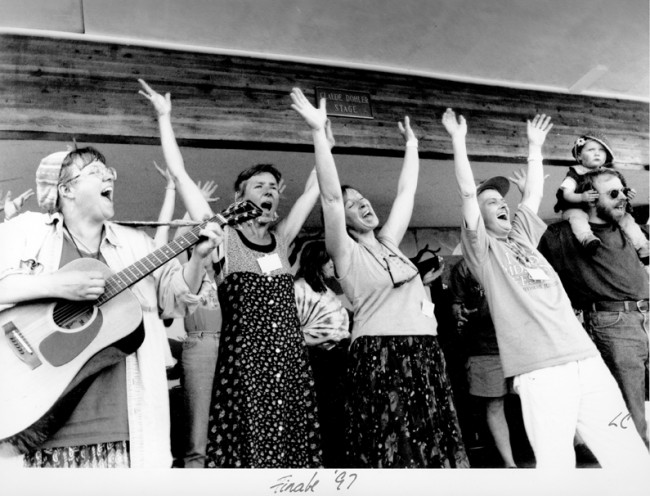
Photo Credit: Lorne Clarke -- Clarke Action Photography
Midsummer Festival, 30 years on: the stuff of legends
It’s 8 p.m. on a Monday evening, and in the Stokes’ kitchen a Midsummer Music Festival meeting has just wrapped up. A teapot and half-empty wine bottle sit on the table. But what flows most generously are the stories.
The coordinators for Smithers’ annual music festival are putting the finishing touches on the 30th Midsummer’s event, set to take place July 5-7 at Smithers’ fall fair grounds. Some, like Kajun Tuite, are new to the team. Others, like George and Norma Stokes, have been involved since the beginning.
Keeping the festival going has its challenges, they tell me, but it’s clear the group has developed a rhythm. They are the ones that connect the volunteers, musicians and vendors—the limbs that make the festival dance. They are Midsummer’s beating heart.
And everyone has stories.
There was the band that played naked. Bad Taste Workshops that hit new lows. Erley climbing into the chicken cage. Meeting life partners, watching children grow—it all happened at Midsummer. But ultimately, the festival is about music and it doesn’t take long before the conversation turns to past performers: Ken Whitely, Finjan, the Plaid-Tongued Devils.
“How about the year that Mother Tongue came and it rained?” Janet Walford remembers.
“That was the first year we had a mosh pit,” adds Karen Diemert.
“Mothers panicking to Mother Tongue!” Jo-Anne Nugent laughs, adding: “Oscar Lopez. He blew my mind. It woulda been ’97 or ’98.”
Then there was the year American blues artist Taj Mahal played. That was 1991, when the province announced Music ’91—BC’s Year of Music, offering festivals a wish-list of acclaimed performers to choose from. It was also the first year the festival turned a profit.
Leading principles
But let’s back up. It was many years of fundraising and hard work before Midsummer organizers found themselves in the black.
The Midsummer Music Festival was inspired by a one-day bluegrass festival that took place at the Driftwood Hall in 1982. Original Midsummer organizer Marian Rose, who now lives in Quebec, decided there should be an annual music event. A handful of people attended the first meeting.
“They decided we’d have a music festival, but we’d incorporate ourselves into a society first,” Karen says. “What the Society Act did was give us a constitution where we have our four leading principles as to why we exist.”
Completely volunteer-run since its inception, the festival started on a $500 budget with funds contributed by the organizers. It was 1984 and the lineup was almost exclusively from northern BC. A week before the event, organizers snagged a Chilean band that was travelling through the area. The rest of the performers, like the Endako Philharmonic, were from the region. George and Norma also played.
“It was a place for people to go and play. That’s why we did it,” Norma says.
It snowed that year. In fact, unpredictable northern weather has plagued the festival on more than one occasion. It never came easily, the coordinators tell me, and throughout the years the Bulkley Valley Folk Music Society (BVFMS) held fundraisers between music festivals, like coffeehouses and the popular Valentino’s party at Driftwood in mid-February.
When Midsummer suddenly turned a $20,000 profit in 1991, the money went right back into the music community. The BVFMS seed-funded the Kispiox Valley Music Festival, Haida Gwaii’s Edge of the World Festival and, later, Robson Valley’s Music Festival.
The result: the acclaimed festival circuit northern BC knows today.
The BVFMS also gave $2,000 a year in scholarships for high school students showing musical talent. In 1996, it started Smithers’ Adult Guitar Camp and, a few years later, the Younger Guitar Camp, both of which continue to attract accomplished instructors and draw out aspiring and experienced musicians every August.
Careful what you wish for
“The festival has always had a family bent to it, right from the beginning,” Karen says. “When we started we all had little babies. Then our babies grew and became teenagers.”
As the coordinators’ children entered their awkward years, it could be said that the festival followed suit. In an attempt to attract more teens, coordinators found themselves amidst something akin to a high-school pit-party.
“Careful what you wish for,” George says. “We spent four years being the alcohol Nazis.”
After several years of suspending camping at the festival, Midsummer found its stride again, leaving those rowdy years behind. Those teens have grown into adults, some of them becoming coordinators—and parents—themselves.
But that doesn’t mean the festival has left its growing pains behind.
In 2007, as flooding threatened the fall fair grounds, Midsummer underwent a last-minute relocation to Heritage Park in downtown Smithers, proving that even after 25 years a festival’s existence is still perilous.
“The flood a few years ago was pretty hard,” Jo-Anne comments. “We never know when a flood’s going to come, and when there’s a flood we lose $20,000 overnight.”
The festival survived (and now, quite literally, keeps a rainy-day fund), making it not only the first festival in northern BC, but now the province’s longest-running camping festival.
The secret is being flexible, George says. Going with the flow: “The festival is kind of a living thing. Every year you adjust to things that happened the year before,” he says.
Music exposure
Over the years, little has changed within the festival’s organization. The four guiding principles remain the same: promote the appreciation of folk music; provide opportunities for folk music performance; offer the chance for local residents to hear folk music; and promote the development of folk music in the region. In short, expose people of the North to music they may have otherwise had to travel a distance to experience.
“And by exposing, we don’t mean bands getting naked,” George clarifies.
Year to year, the festival is never on completely solid ground. There’s always a need for more volunteers, for more money. There is the unpredictable northern weather to contend with. But today the festival attracts roughly 3,000 people annually and, sitting around the Stokes’ dining room table, I see a group that has hit its stride over the years—and looks forward to making its 30th event another one to add to the library of stories.
This year, they’re bringing back past performers Oscar Lopez and James Keelaghan. Also headlining are Del Barber and Canadian pop trio Hey Ocean. And there will be a slate of local talent to round out the lineup.
Next to the Stokes’ basement door, where the Midsummer coordinators chat while they put on shoes, I’m distracted by two black-and-white framed photographs. The first draws me in because I think I recognize some of the singers on stage for the closing number in 1997.
The other shows festival-goers entertaining themselves with a broomstick limbo bar in front of Main Stage. That’s the year the power went out all over town, right in the middle of the Saturday evening show. Did the grounds clear out? Were people demanding their money back? Far from it. The stage area is still packed, with people just hanging out and having fun.
Today, it’s just another story.





